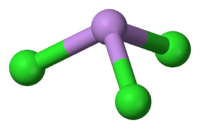Arsenic trichloride
 | |
| Names | |
|---|---|
| Other names
Arsenic(III) chloride, Arsenous trichloride, Butter of arsenic, de Valagin's solution | |
| Identifiers | |
| 7784-34-1 | |
| ChemSpider | 22974 |
| |
| Jmol-3D images | Image |
| PubChem | 24570 |
| RTECS number | CG1750000 |
| |
| Properties | |
| AsCl3 | |
| Molar mass | 181.28 g/mol |
| Appearance | colourless liquid |
| Density | 2.163 g/cm3, liquid |
| Melting point | −16.2 °C (2.8 °F; 256.9 K) |
| Boiling point | 130.2 °C (266.4 °F; 403.3 K) |
| decomposes | |
| Solubility | soluble in alcohol, ether, HCl, HBr |
| Refractive index (nD) |
1.6006 |
| Viscosity | 9.77 x 10−6 Pa s |
| Hazards | |
| EU classification | Very Toxic (T+) Dangerous for the environment (N) |
| R-phrases | R23/25, R50/53 |
| S-phrases | (S1/2), S20/21, S28, S45, S60, S61 |
| NFPA 704 | |
| LD50 (Median lethal dose) |
48 mg/kg |
| Related compounds | |
| Other anions |
Arsenic trioxide |
| Other cations |
Antimony trichloride |
| Except where noted otherwise, data is given for materials in their standard state (at 25 °C (77 °F), 100 kPa) | |
| | |
| Infobox references | |
Arsenic trichloride is an inorganic compound with the formula AsCl3, also known as arsenous chloride or butter of arsenic. This poisonous oil is colourless, although impure samples may appear yellow. It is an intermediate in the manufacture of organoarsenic compounds.[1]
Structure
AsCl3 is a pyramidal molecule with C3v symmetry. The As-Cl bond is 2.161 Å and the angle Cl-As-Cl is 98° 25'±30.[2][3] AsCl3 has four normal modes of vibration: ν1(A1) 416, ν2(A1) 192, ν3 393, and ν4(E) 152 cm−1.[4] Arsenic trichloride contains predominantly covalent bonds, which explains its low melting point.
Synthesis
This colourless liquid is prepared by treatment of arsenic(III) oxide with hydrogen chloride followed by distillation:
- As2O3 + 6 HCl → 2 AsCl3 + 3 H2O
It can also be prepared by chlorination of arsenic at 80–85 °C, but this method requires elemental arsenic.[1]
- 2 As + 3 Cl2 → 2 AsCl3
Arsenic trichloride can also be prepared by the reaction of arsenic oxide and sulfur monochloride. This method requires simple apparatus and proceeds efficiently:[5]
- 2 As2O3 + 6 S2Cl2 → 4 AsCl3 + 3 SO2 + 9 S
Reactions
Hydrolysis with water gives arsenous acid and hydrochloric acid:
- AsCl3 + 3 H2O → As(OH)3 + 3 HCl
Although AsCl3 is less moisture sensitive than PCl3, it still fumes in moist air.[6]
AsCl3 undergoes redistribution upon treatment with As2O3 to give the inorganic polymer AsOCl. With chloride sources, AsCl3, forms salts containing the anion [AsCl4]−. Reaction with potassium bromide and potassium iodide give arsenic tribromide and arsenic triiodide, respectively.
AsCl3 is useful in organoarsenic chemistry, for example triphenylarsine is derived from AsCl3:[7]
- AsCl3 + 6 Na + 3 C6H5Cl → As(C6H5)3 + 6 NaCl
Safety
Arsenic compounds are highly toxic, and AsCl3 especially so because of its volatility and solubility.
References
- ↑ 1.0 1.1 Sabina C. Grund, Kunibert Hanusch, Hans Uwe Wolf "Arsenic and Arsenic Compounds" in Ullmann's Encyclopedia of Industrial Chemistry, VCH-Wiley, 2008, Weinheim.doi:10.1002/14356007.a03_113.pub2
- ↑ P. Kisliuk; C. H. Townes. "The Microwave Spectra and Molecular Structure of Phosphorus and Arsenic Trichloride". J. Chem. Physics 1950, 18.
- ↑ Jean Galy; Renee Enjalbertl Pierre Lecante; Andrzej Burian "AsCl3: From the crystalline to the liquid state. XRD (176< T (K) < 250) and WAXS (295K) studies" Inorg. Chem 2002, volume 41, pp. 693–698.doi:10.1021/ic0102788
- ↑ Klapoetke, Thomas M. "The vibrational spectrum of arsenic trichloride" Main Group Metal Chemistry 1997, volume 20, pp. 81–83.
- ↑ R. C. Smith, "Manufacture of Arsenic trichloride" The Journal of Industrial and Engineering Chemistry 1919, volume 11, pp. 109–110. doi:10.1021/ie50110a009
- ↑ Holleman, A. F.; Wiberg, E. Inorganic Chemistry Academic Press: San Diego, 2001. ISBN 0-12-352651-5.
- ↑ Shriner, R. L.; Wolf, C. N. (1963). "Tetraphenylarsonium Chloride Hydrochloride". Org. Synth.; Coll. Vol. 4, p. 910. Describes the preparation of As(C6H5)3.
| ||||||
